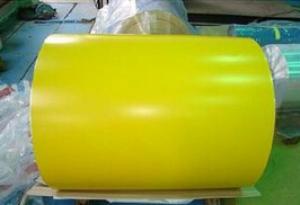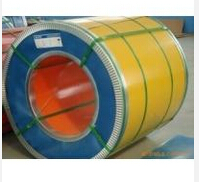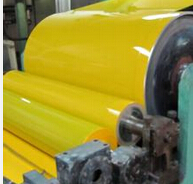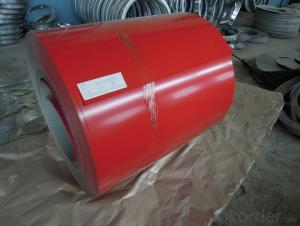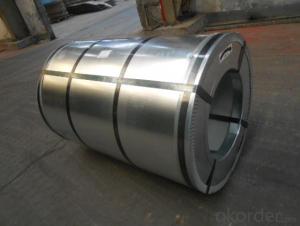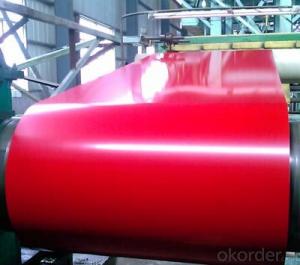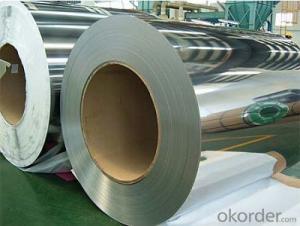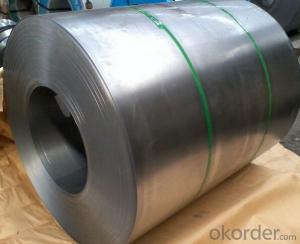High Anti-Corrosion Color Coated Steel Coil
- Loading Port:
- China Main Port
- Payment Terms:
- TT OR LC
- Min Order Qty:
- -
- Supply Capability:
- -
OKorder Service Pledge
OKorder Financial Service
You Might Also Like
Specification
1. Thickness: 0.3-0.8mm
2. Width: 914-1250mm
3. Inner Diameter: 508mm
4. Weight of Steel Coil: 3-15MT
5. Available Dipped Layer: 50-150g/m2
6. Surface Texture: Normal Coated
7. Type of coating structure: 2/1 Coat the top surface of the steel sheet twice, coat the bottom surface once, and bake the sheet twice.
8. Front side paint thickness: 15-25μm (bottome paint + top paint)
9. Back side paint thickness: 5-10μm
Mechanical Properties
1. Mechanical properties of base metals
Grade | Tensile Test | ||
Yield Strength MPa | Tensile Strength MPa | Elongation A80mm % ≥ | |
DC51D+AZ | 280-325 | 320-500 | 22 |
DC52D+AZ | 240-300 | 270-420 | 26 |
DC53D+AZ | 140-260 | 270-380 | 30 |
2. Common performance of front coating
(1). Thickness: ≥20μm
(2). Pencil Hardness: 2H
(3). 60° specular glossiness of coating: >60
(4). 180°bend: ≤3T
(5). Impact: ≥9J
(6). Salt Fog Resistant: ≥500h
(7). Color difference: <3ΔE
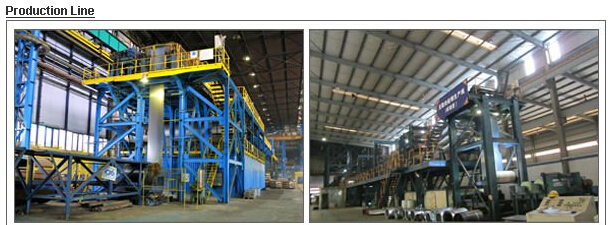
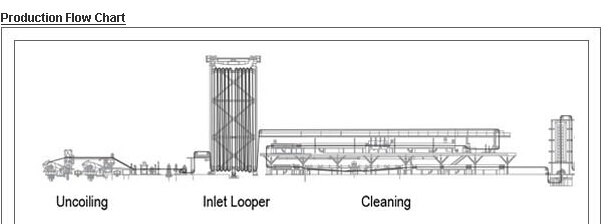
- Q: I recently got in a car accident with a steel mailbox, on a snowy day. I was wondering if i can do anything since the steel mailbox caused my car to be totaled. Otherwise it would have been fine and would have suffered only minor damage. Anything I can do here to maybe get some money back? Thanks!
- This will be a collision claim for you, if you have collision you can file a claim and you'll have to pay a deductible, whatever it is. The owner of the mailbox can also file a claim on your insurance since you damaged his/her mailbox. If you don't have collision coverage you won't get squat - this accident is 100% your fault. The steel mailbox didn't cause your car to get totaled, your driving did.
- Q: What are the different types of welding used for steel coils?
- Steel coil fabrication involves the utilization of various welding techniques, each catered to specific requirements and applications. Here, we present some commonly employed welding methods for steel coil fabrication: 1. Stick welding, also known as Shielded Metal Arc Welding (SMAW), utilizes a flux-coated electrode and an electric current to generate an arc between the electrode and the base material. SMAW is a versatile and extensively used technique suitable for a range of steel coil applications. 2. Gas Metal Arc Welding (GMAW), also referred to as MIG (Metal Inert Gas) welding, employs a continuous wire electrode and a shielding gas to safeguard the weld pool against atmospheric contamination. GMAW is renowned for its high welding speed and ease of automation, making it a favored choice for steel coil manufacturing. 3. Flux-Cored Arc Welding (FCAW) shares similarities with GMAW, but employs a tubular electrode with flux inside. The flux serves as both the shielding gas and added alloying elements, resulting in enhanced efficiency and weld quality. FCAW is often employed for high-speed welding applications in steel coil fabrication. 4. Gas Tungsten Arc Welding (GTAW), also known as TIG (Tungsten Inert Gas) welding, employs a non-consumable tungsten electrode and an inert gas, typically argon, to protect the weld area. GTAW delivers high-quality, precise welds with exceptional control over heat input, rendering it suitable for thin steel coil materials and critical welding scenarios. 5. Submerged Arc Welding (SAW) involves the use of a continuously fed wire electrode and a granular flux that covers the weld area. The arc is submerged beneath the flux, providing excellent protection and minimizing the need for post-weld cleaning. SAW is commonly employed for welding thick steel coils due to its high deposition rates and deep penetration capabilities. These examples highlight the diverse range of welding techniques employed in steel coil fabrication. The selection of the appropriate welding method depends on factors such as the specific steel grade, thickness, desired weld quality, production speed, and cost considerations. It is crucial to choose the suitable welding technique to ensure the longevity and performance of steel coils across different applications.
- Q: what is the stucture of high carbon steel
- That is kind of a broad question because high carbon steel can cover a broad range and you did not mention the condition. But I will try to keep it simple. If it is in a wrought condition, it would likely be pearlite plus carbides along the grain boundaries., The atomic structure would be body centered cubic. Sometimes high carbon steel is spherodized annealed and that would be ferrite with lots of round carbides. The atomic structure would be body centered cubic. If it is quench and tempered, it would be martensite and would probably have noticeable carbides if the carbon content was high enough. The atomic structure would be body centered tetragonal
- Q: How are steel coils used in the manufacturing of electrical wiring?
- Steel coils are not typically used directly in the manufacturing of electrical wiring. However, steel coils can be used in the production of wire drawing machines, which are used to stretch and shape the copper or aluminum wire used in electrical wiring.
- Q: I have hundreds of pounds of scrap steel... who purchases this steel and what is the price per pound etc. of this? Does someone pick it up or do I bring it somewhere?
- It okorder /
- Q: What are the different methods of storing steel coils?
- There are various ways to store steel coils depending on the specific requirements and limitations of the storage facility. Some commonly used methods include: 1. Stacking: Steel coils are stacked on top of one another in a stable manner, maximizing vertical space. However, careful stacking is necessary to maintain stability and prevent damage. 2. Block stacking: Steel coils are arranged in blocks, with each coil placed directly on top of another. The blocks are then stacked to optimize space. This method provides stability and easy access to individual coils, but additional equipment may be needed to prevent damage. 3. Coil cradles: These are specialized racks or frames designed to hold steel coils horizontally. They offer support and prevent rolling or shifting, making them suitable for smaller coils or when quick access is required. 4. Coil saddles: U-shaped frames specifically designed to hold and support steel coils vertically. They are often used in conjunction with block stacking or stack storage methods, providing stability and preventing rolling or collapsing. 5. Coil racks: Steel structures designed to hold multiple coils in an organized manner. They can have multiple levels or tiers, maximizing space efficiency. Coil racks are typically used for larger coils and can be customized for specific dimensions. 6. Automated storage systems: In large-scale facilities, mechanical systems such as coil cranes or coil carousels are used to transport and store steel coils. These systems ensure efficient and fast retrieval in high-volume operations where frequent coil handling is necessary. When determining the most suitable storage method for steel coils, factors such as size, weight, accessibility, and environmental conditions should be considered. Proper handling, labeling, and regular inspections are also crucial for maintaining the integrity and longevity of the stored coils.
- Q: What are the common coil diameters available for steel coils?
- Steel coils come in a range of common diameters depending on the industry and purpose. Generally, the most frequently used coil diameters for steel range from 24 inches to 72 inches. These diameters are commonly utilized in sectors like automotive, construction, and manufacturing. It should be noted that the required coil diameter might vary depending on factors such as the material's size and weight, the equipment used for coil handling, and the specific requirements of the end-use application.
- Q: I have a steel string, Yamaha acoustic guitar that I am learning to play at home. But at school I use a rented nylon string guitar. I like the feel of the nylon strings better then the steel strings and i was wondering if i can just switch strings or if i should just get another guitar. Can anyone help?
- confusing thing. query using bing and yahoo. this will help!
- Q: How are steel coils used in the production of storage tanks and silos?
- Steel coils are used in the production of storage tanks and silos as they provide the necessary structural strength and durability required for these storage structures. The coils are formed, cut, and welded into the desired shape to create the walls and roofs of the tanks and silos. This ensures that the storage vessels can withstand the weight of the stored materials and any external forces exerted on them.
- Q: Is a steel plate the same as a steel coil?
- You must have an open book and a flat plate, and it is a little bit harder to cut the parts than the plate.
Send your message to us
High Anti-Corrosion Color Coated Steel Coil
- Loading Port:
- China Main Port
- Payment Terms:
- TT OR LC
- Min Order Qty:
- -
- Supply Capability:
- -
OKorder Service Pledge
OKorder Financial Service
Similar products
Hot products
Hot Searches
Related keywords
